 

The
Development of Hong Kong Tugboat Services
|
 Tug boats are referred to those motorboats used for towing purposes. Tug boats have been in existence since the establishment of the Hong Kong port. In early days, the tug boats were small in hull and in engine power. The main towing objects were small crafts, floating wood and bamboo rafts. Tug boats are referred to those motorboats used for towing purposes. Tug boats have been in existence since the establishment of the Hong Kong port. In early days, the tug boats were small in hull and in engine power. The main towing objects were small crafts, floating wood and bamboo rafts.
Occasionally, tug boats were deployed to tow wooden cargo barge to Macau and Pearl Delta ports.
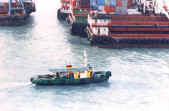 The pre-war tug boats were made from wood, powered by steam, with fuel in firewood, charcoal and coal. Horse power ranged from 40 HP to 100 HP. Sun Chuen Lee, Kwong Sang, Kam Sang, Kwai Sang and Kwong Shui were the prominent names of pre-war tug boats. Due to the use of bulky fuel, each vessel was manned by 8-10 crew.
After the Second World War, the Government imported several tugs powered by diesel combustion engine, to compensate the owners of those vessels which have been mobilised by the Government during the war. The engines of these vessels were mainly Grey and Perkins, with power ranged from 50 to 200 HP. The use of diesel as fuel greatly reduced the size of crew in the vessels. The pre-war tug boats were made from wood, powered by steam, with fuel in firewood, charcoal and coal. Horse power ranged from 40 HP to 100 HP. Sun Chuen Lee, Kwong Sang, Kam Sang, Kwai Sang and Kwong Shui were the prominent names of pre-war tug boats. Due to the use of bulky fuel, each vessel was manned by 8-10 crew.
After the Second World War, the Government imported several tugs powered by diesel combustion engine, to compensate the owners of those vessels which have been mobilised by the Government during the war. The engines of these vessels were mainly Grey and Perkins, with power ranged from 50 to 200 HP. The use of diesel as fuel greatly reduced the size of crew in the vessels.
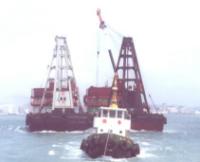 In mid 60s, Government restricted the towing of floating wood and bamboo rafts in the Hong Kong Waters. This measure directly promoted the growth of motorised cargo vessels and dumb steel lighters. Without engine, the lighters relied tug boat to move around. At that time, the lighters were mainly used to carry break bulk cargo, with loading capacity from 200 to 800 MT. In mid 60s, Government restricted the towing of floating wood and bamboo rafts in the Hong Kong Waters. This measure directly promoted the growth of motorised cargo vessels and dumb steel lighters. Without engine, the lighters relied tug boat to move around. At that time, the lighters were mainly used to carry break bulk cargo, with loading capacity from 200 to 800 MT.
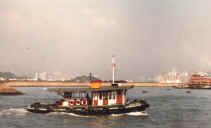 In late 70s, a fleet of about 12 steel tugs were built with a standard 365 HP engine. The modern design, stronger build, more powerful towing capacity and improved manoeuvrability prompted other operators to replace the wooden tugs with steel ones. The Caterpillar and Cummins engines replaced Gardner and became the more popular models. In late 70s, a fleet of about 12 steel tugs were built with a standard 365 HP engine. The modern design, stronger build, more powerful towing capacity and improved manoeuvrability prompted other operators to replace the wooden tugs with steel ones. The Caterpillar and Cummins engines replaced Gardner and became the more popular models.
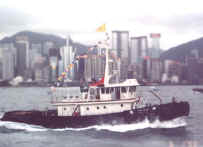 In mid 80s, the lighters joined the current of containerisation. The lighters began with the size of 9 TEU/layer (ie. one layer with 9 twenty-foot equivalent units) and grew to 12 TEU and 16 TEU. To handle the larger lighters, the tugs began to adopt a more powerful engine with 400-500 HP. In mid 80s, the lighters joined the current of containerisation. The lighters began with the size of 9 TEU/layer (ie. one layer with 9 twenty-foot equivalent units) and grew to 12 TEU and 16 TEU. To handle the larger lighters, the tugs began to adopt a more powerful engine with 400-500 HP.
During 1987-1993, mid-stream operations services were in high tide and at the same period, the marine engineering works were also booming. The size of lighters jumped from 16 TEU/layer to 20, 22, 24-26, and 30-33 TEU/layer within a relatively short period. The engine power of tugs also increased correspondingly to 600-1200 HP.
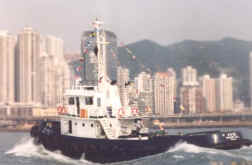 In the evolution process of tug boats, the manning in the vessel has undergone significant changes. The pre-war steam wooden tugs were manned by 8-10 crew, including 1-2 coxswains, 1 engine operator, 2 deckhands, 2 fuel assistant, 1 bell boy and 1 cook. The use of diesel by the steel tug in recent years has cut down the size of crew to 3, including 1 coxswain, 1 engine operator and 1 deckhand. In the evolution process of tug boats, the manning in the vessel has undergone significant changes. The pre-war steam wooden tugs were manned by 8-10 crew, including 1-2 coxswains, 1 engine operator, 2 deckhands, 2 fuel assistant, 1 bell boy and 1 cook. The use of diesel by the steel tug in recent years has cut down the size of crew to 3, including 1 coxswain, 1 engine operator and 1 deckhand.
The communication method used in the tug boats has undergone great changes as well. In the pre war days, the summon of tugboat service relied on some visual signals eg. hoisting a jute bag at the front of the vessel. If the cargo vessel hoisted its company flag mid-mast, only its own contracted tug was required. The crew of the tugs have to keep a constant watch on their company's signal - may be a flag or other symbols hoisted at the company's offices which were mainly in the waterfront. After the war, some seafarers joined the tugboat service and began to introduce radio communication to the trade. Nowadays, apart from VHF, mobile telephone is widely used. Radar and GPS (Global Positioning System) are common equipments.
At present, there are about 200 local tugs. In addition, there are a further 30-40 ocean tugs with engine power from 2000 HP to over 10000 HP. The ocean tugs are not the subject of discussion in this article and they are mainly used to assist ocean going vessels in berthing and in salvage in open seas.
|
Choi Kim Lui
Chairman
MBTA (1999-2001)
28.11.2000
|
|
|
| |
|